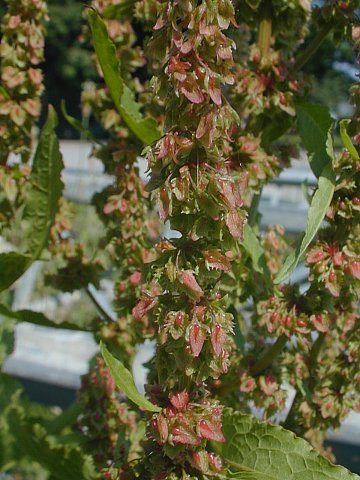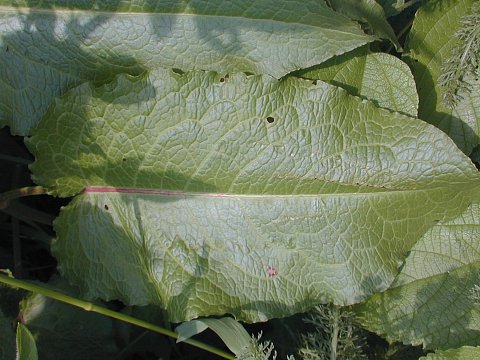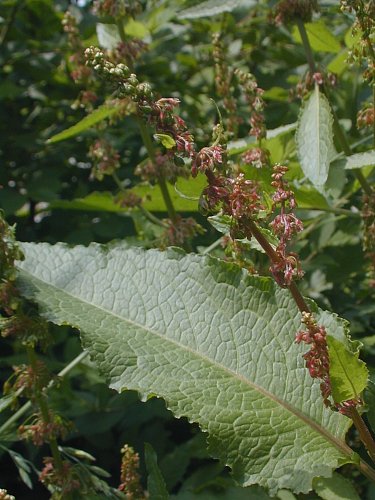Description:
This herbaceous perennial plant is 2-3½' tall. Initially, it consists
of
a rosette of basal leaves, from which one or more flowering stalks
develop. The basal leaves are up to 1' long and 4" across.
Their petioles are long and slender, while their
blades are oblong-ovate or oblong-cordate, crisped and slightly
undulate along the margins, and glabrous. The central vein of each
basal leaf is often tinted red, and a reticulated network
of fine
secondary veins is observable across the upper surface. The leaf base
is slightly cordate or well-rounded, rather than tapering or
wedge-shaped. The cauline leaves alternate along the flowering stalks.
They are similar in appearance to the basal leaves, although somewhat
shorter in length and more narrow; their petioles are also shorter. The
stalks are round, slightly ribbed, and glabrous; they often have
prominent longitudinal veins that are tinted red. Each stalk terminates
in a panicle of whorled racemes up to 1' in length. The whorls of
greenish red flowers are somewhat interrupted along the length of the
racemes. The flowers droop downward from pedicels about ½" in length
when they are fully developed. Each flower is about ¼" long, consisting
of 6 sepals (3 inner and 3 outer sepals) and no petals. Like other Rumex
spp. (Docks), Bitter Dock is monoecious and has staminate
(male) and pistillate (female) flowers on the same plant. Both types of
flowers are intermingled together on the racemes. The male flowers have
6 stamens and inner sepals that are dull yellow, while the female
flowers have a pistil and inner sepals that are often red. As the
female flowers develop, their inner sepals become enlarged and surround
a single tubercle (hard-coated seed). Each face of this tripartite
fruit is oval-cordate or oval-deltoid in shape; its margins are
membranous and there are 2-4 spiny teeth along each margin,
particularly in the upper half. In bright sunlight, these fruits often
turn bright red and are rather colorful. The blooming period usually
occurs during the late spring and lasts about 2 weeks, after which the
fruits mature slowly during the first half of the summer. The flowers
are wind-pollinated and there is no floral scent. The hard-coated seeds
are ovoid-oblongoid and rather large in size. Surrounded by the
membranous inner sepals, they can float on water or blow about in the
wind. The root system consists of a stout taproot. This plant spreads
by reseeding itself.
is often tinted red, and a reticulated network
of fine
secondary veins is observable across the upper surface. The leaf base
is slightly cordate or well-rounded, rather than tapering or
wedge-shaped. The cauline leaves alternate along the flowering stalks.
They are similar in appearance to the basal leaves, although somewhat
shorter in length and more narrow; their petioles are also shorter. The
stalks are round, slightly ribbed, and glabrous; they often have
prominent longitudinal veins that are tinted red. Each stalk terminates
in a panicle of whorled racemes up to 1' in length. The whorls of
greenish red flowers are somewhat interrupted along the length of the
racemes. The flowers droop downward from pedicels about ½" in length
when they are fully developed. Each flower is about ¼" long, consisting
of 6 sepals (3 inner and 3 outer sepals) and no petals. Like other Rumex
spp. (Docks), Bitter Dock is monoecious and has staminate
(male) and pistillate (female) flowers on the same plant. Both types of
flowers are intermingled together on the racemes. The male flowers have
6 stamens and inner sepals that are dull yellow, while the female
flowers have a pistil and inner sepals that are often red. As the
female flowers develop, their inner sepals become enlarged and surround
a single tubercle (hard-coated seed). Each face of this tripartite
fruit is oval-cordate or oval-deltoid in shape; its margins are
membranous and there are 2-4 spiny teeth along each margin,
particularly in the upper half. In bright sunlight, these fruits often
turn bright red and are rather colorful. The blooming period usually
occurs during the late spring and lasts about 2 weeks, after which the
fruits mature slowly during the first half of the summer. The flowers
are wind-pollinated and there is no floral scent. The hard-coated seeds
are ovoid-oblongoid and rather large in size. Surrounded by the
membranous inner sepals, they can float on water or blow about in the
wind. The root system consists of a stout taproot. This plant spreads
by reseeding itself.
Cultivation:
The preference is full or partial sun, moist to mesic conditions, and a
loamy fertile soil. This robust plant will grow readily in less
favorable situations, but it will be smaller in size. It can tolerate
temporary flooding and is more often in partially shaded situations
than many other Rumex spp. (Docks). The seeds of
Docks can persist in the ground for several decades and remain viable.
Range & Habitat: The
non-native Bitter Dock is a fairly common plant that occurs in the
majority of counties in Illinois; it is least common in the NW and
north central areas of the state (see Distribution
Map). Habitats include moist woodland edges, seeps,
semi-shaded areas along streams, gardens and edges of yards, areas
along buildings, vacant lots, roadside ditches, and waste areas. Bitter
Dock is native to Eurasia and prefers disturbed areas.

Faunal Associations: Because the flowers are wind-pollinated, they attract few pollinating insects. Sometimes beetles and other insects lurk in the dense whorls of flowers and fruits. The foliage of Docks is eaten by the caterpillars of Copper butterflies, including Lycaena hyllus (Bronze Copper) and Lycaena helloides (Purplish Copper). The caterpillars of some moths also eat the foliage of Docks, including Phragmatobia fuliginosa (Ruby Tiger Moth), Sunira bicolorago (Bicolored Sallow), and Phlogophora iris (Olive Angle Shades). The caterpillars of the moth Luperina passer (Rustic Dock) feed on the roots. Various birds eat the seeds of Docks, including the Greater Prairie Chicken, Bobwhite, Redwing Blackbird, Bobolink, Swamp Sparrow, and Song Sparrow. The seeds of Docks are also eaten by some sparrows during the winter, including the Vesper Sparrow, Fox Sparrow, and White-Crowned Sparrow. Ducks occasionally eat the seeds of plants occurring in wetland areas. Mammalian herbivores usually shun the foliage of mature plants because it is bitter and slightly toxic (containing oxalates and nitrates). When livestock are fed the flowering stalks of dock, the seeds can pass through their digestive tracts and remain viable. Thus, these animals can help to spread the seeds into new areas.

Photographic
Location:
The plants in the photographs occurred in a vacant lot and along a
roadside in Urbana, Illinois.
Comments:
Bitter Dock is one of the more ornamental species of Docks. It is
fairly easy to distinguish from other Docks by its shiny leaves, which
are rather broad, well-rounded or cordate at the base, and crisped
along their margins. Another distinctive characteristic is the
appearance of the calyx, which has spiny teeth along its margins.
Another common name for this species is Broad-Leaved Dock.